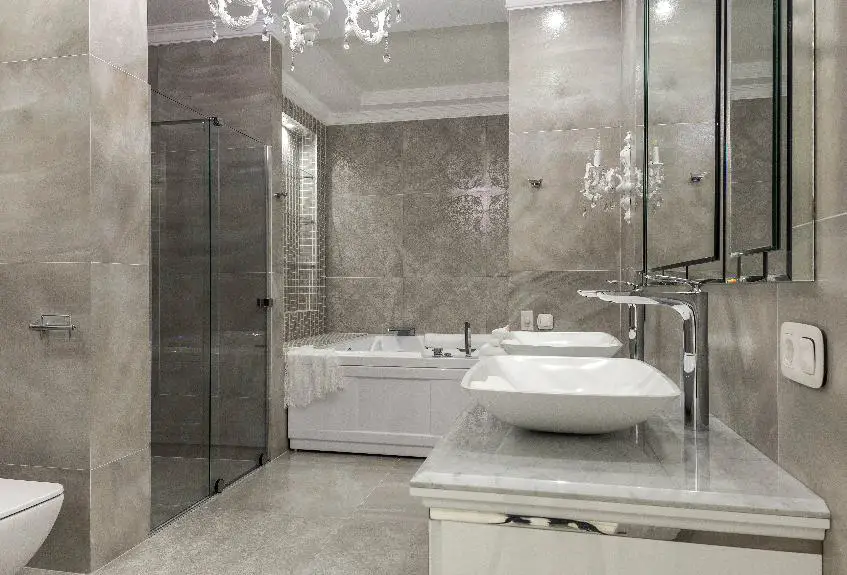Double sink vanities in modern bathrooms typically have two basins, each with its own drain. These drains usually merge into a single P-trap before connecting to the main waste line. This setup is both efficient and compliant with plumbing codes, which helps prevent sewer gases from entering the home.
Installing a double sink vanity requires careful planning and proper plumbing to function correctly and be reliable over time.
Understanding Double Vanity Plumbing
In a double vanity with two sinks, both can connect to one P-Trap if the distance between drains is less than 30 inches, as per plumbing codes. This saves space and materials. The setup usually involves a T-shaped pipe configuration, where both sink drains merge into the P-Trap. The trap arm then connects to the main drain pipe with a slope of at least 1/4 inch per foot for proper water flow and to avoid clogs.
If the sinks are over 30 inches apart, they cannot share a P-Trap, and each must have its own, installed at the cabinet's rear to maximize storage space. Following these rules ensures an efficient and compliant double vanity installation.
Double Vanity Drain Configurations
When installing a double sink vanity, the plumbing must be configured for both functionality and building code compliance. If the distance between the two sink drains is 30 inches or less, a single P-trap can be used. This setup involves a sanitary tee for connection and conserves space.
For basins close enough, install a shared P-trap with a sanitary tee at the back wall, ensuring proper drainage and a slope of 1/4 inch per foot for water flow.
If the sinks are more than 30 inches apart or the wall pipe's height does not permit a shared P-trap, two separate P-traps are required. Each sink will have its own drain line linked to its P-trap before connecting to the main drain. This method requires more plumbing but is necessary for code compliance and efficient drainage.
Installations must follow plumbing codes to prevent issues and ensure the double sink vanity functions properly.
Installation Considerations
When installing a double sink vanity, it is necessary to account for space, adhere to plumbing codes, and manage water flow effectively.
The sink drains should be no more than 30 inches from the P-Trap to prevent sewer gas entry and ensure sanitation.
A second P-Trap may be installed at the back of the cabinet to increase water flow and maximize storage space. Drain pipes must have a slope of 1/4 inch per foot for proper drainage, as required by the International Plumbing Code.
Water supply lines must be connected carefully to prevent leaks and allow easy access for repairs. Local plumbing codes must be followed throughout the installation.
If the sinks are far apart, a second P-Trap can also reduce noise from water in the pipes.
Common Double Sink Myths
There are misconceptions about double sink vanities and their plumbing requirements. One myth is that double sinks cannot share a single drain system effectively. However, it is possible for a double sink to use one drain if the installation complies with plumbing regulations.
It is often believed that having two drains is better than one to prevent clogs, but the plumbing code permits a single P-Trap for two sinks if they are within 30 inches of each other. This shows that one drain can work for two sinks. The plumbing code also suggests a slope of 1/4 inch per foot for good drainage, simplifying plumbing for a double sink.
Some think that two sinks need two traps to work properly and avoid odors. While two traps can be installed, it's not always necessary. Using an S trap is not recommended and is not code-compliant due to siphoning issues. A sanitary tee is an acceptable alternative for a proper connection.
Lastly, concerns about noise from water traveling to a distant P-Trap are not justified. A second P-Trap can be used to lessen noise, but it is not required. By clearing up these myths, individuals can install double sink vanities correctly and confidently.
Maintenance and Troubleshooting
Maintenance and troubleshooting are important for the efficiency and functionality of a double sink vanity using a shared drain. To prevent clogs and leaks, clean the stoppers and use a strainer to trap debris. Flush the drain with hot water regularly to clear soap and oil buildup. If a clog occurs, use a plunger with the other sink's drain sealed to increase pressure. For stubborn clogs, you may need a plumber's snake.
To fix leaks, shut off the water supply first, then inspect and tighten the connections and P-Trap. Ensure the P-Trap is within 30 inches of the drains, complying with plumbing codes to prevent leaks.
For noise issues, installing a second P-Trap can reduce sound and must comply with the plumbing code's slope recommendation of 1/4 inch per foot for proper water flow.
Regular inspections and following plumbing codes minimize the need for frequent maintenance and troubleshooting.





